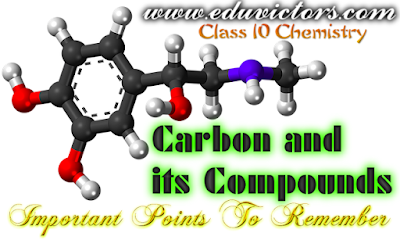Carbon and its Compounds
Important Points To Memorise
1. Carbon forms a large variety of compounds because of its tetra-valency and the property of catenation.
2. Hydrocarbons are the compounds of carbon and hydrogen.
3. Hydrocarbons are of two types – saturated hydrocarbons (alkanes) and unsaturated hydrocarbons (alkenes and alkynes)
4. Carbon forms covalent bonds with itself and other elements such as hydrogen, oxygen, sulphur, nitrogen and chlorine.
5. The functional groups such as alcohols, aldehydes, ketones and carboxylic acids bestow characteristic properties to the carbon compounds that contain them.
6. A group / series of hydrocarbons having similar structure and similar properties (i.e. same
functional group) is called a homologous series.
7. Carbon chains may be in the form of straight chains, branched chains or rings.
8. Carbon compounds with identical molecular formula but different structures are called structural
isomers.
9. Saturated hydrocarbons on combustion gives carbon dioxide and water with lots of heat.
10. Unsaturated hydrocarbons undergo addition reactions while saturated hydrocarbons undergo substitution reactions.
11. Ethanol and Ethanoic acid (glacial acetic acid) are carbon compounds of importance in our daily lives.
12. The molecules of soap are sodium or potassium salts of long chain carboxylic acids.
13. Detergents are ammonium or sulphonate salts of long chain carboxylic acids.
14. The action of soaps and detergents is based on the presence of both hydrophobic and hydrophilic groups in the molecule and this helps to emulsify the oily dirt and hence its removal.

No comments:
Post a Comment
We love to hear your thoughts about this post!
Note: only a member of this blog may post a comment.